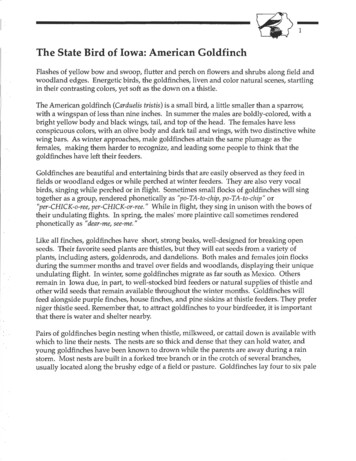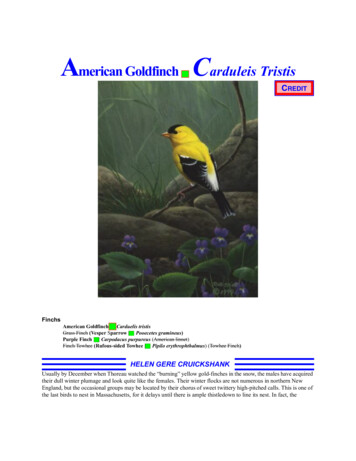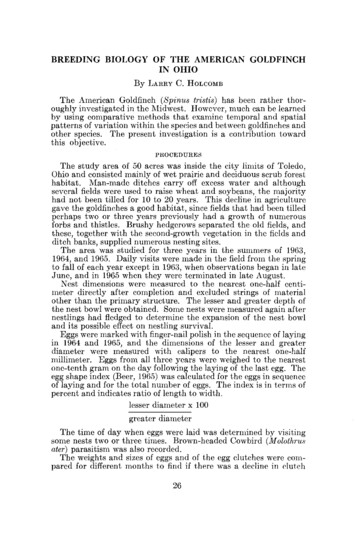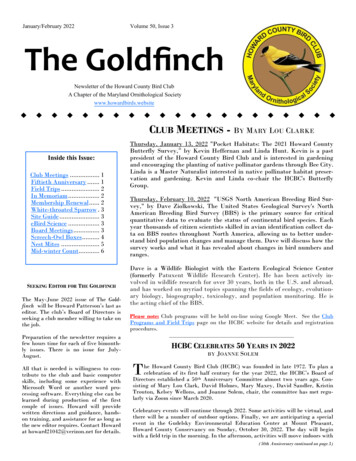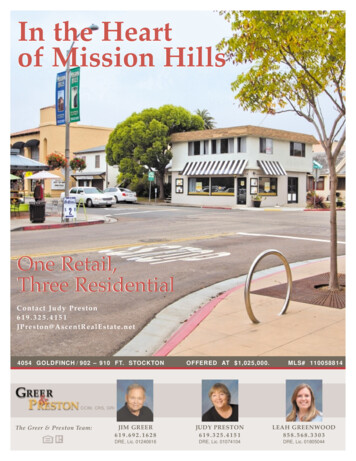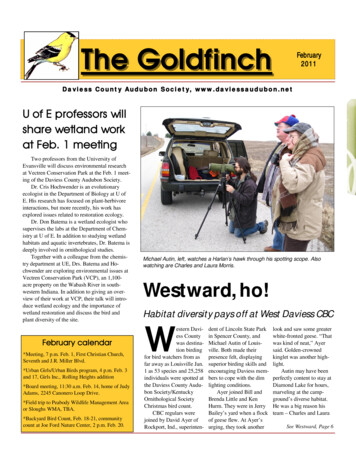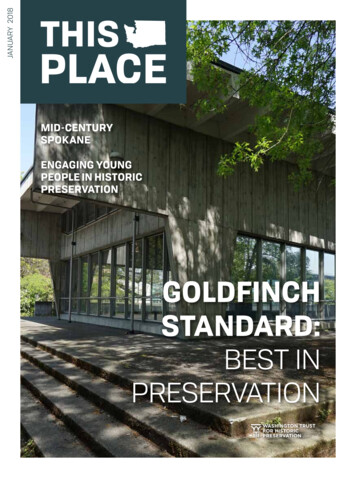
Transcription
JANUARY 2018MID-CENTURYSPOKANEENGAGING YOUNGPEOPLE IN HISTORICPRESERVATIONGOLDFINCHSTANDARD:BEST INPRESERVATION
THIS PLACEJanuary 2018GET INVOLVEDBOARD OF DIRECTORSPresidentPatrick McCutcheon,EllensburgJANUARY 12Most Endangered Places - Nominations DUEVice PresidentHolly Chamberlain, VancouverWe accept nominations for Most Endangered Places yearround, but January 12, 2018 is the deadline to be included inthe official video announcement at Vintage Washington.SecretaryA publication of the Washington Trust for Historic PreservationSusan White, Des MoinesTreasurerJANUARY 16Conference Registration OPENSMark Hannum, Seattle1 UPCOMING DATES2 FRESHEN UPPreservation isn’t static, and preservation organizations shouldn’t beeither. We hope you like our new newsletter, and don’t forget to checkout the new look of preservewa.org if you haven’t already!4 THE GOLDFINCH STANDARDWe take a moment to look back and celebrate historic preservationsuccesses from around Washington during 201710 MID-CENTURY SPOKANEThe Spokane City/County Historic Preservation Office embarked on asurvey of mid-century architecture in Spokane to raise awareness forthe modern buildings that changed the face of the city14 PRESERVE WA FELLOWSOur final PreserveWA Fellows article from 2017, fittingly aboutengaging young people in historic preservation, written by one of thenewest members of our Board of Directors!16 MAIN STREET MATTERS: CENTRALIAA Main Street community on the rise18 DONOR FOCUS: SHKS ARCHITECTSReimagining the Lake City Library and adapting a mid-centurylandmark to accommodate a changing neighborhood21 WHERE IN THE WA?Can you guess this issue’s historic place?22 CHANGES ON THE BOARDWelcoming recent additions to our Board of Directors, including ournew student and young professional trustee positions23 THANKS TO YOUBoard MembersGinny Butler, SpokaneLogan Camporeale, SpokaneA Most Endangered Place from way back in 2003, the Elks Lodge in Tacoma,finally under construction in late 2017. Photo by Susan Johnson.Gideon Cauffman, Oak HarborTanner Dotzauer, WenatcheeRegistration discounts are available for Main StreetCommunities, Certified Local Governments, andWashington Trust members.MARCH 12-14National Preservation Advocacy Week(Lobby Day)Megan Duvall, SpokaneHorace Foxall, SeattleRyan Hester, SeattleJoin our group of citizen lobbyists for a week of advocatingfor national preservation policy in Washington, DC!Travel scholarships are available. Contact our office formore information.David Johnston, BellinghamKevin Kane, SeattleJohn Lantz, Gig HarborPaul Mann, SpokaneAPRIL 23-25Revitalize WA 2018Rob McCoy, PullmanJoe McDermott, SeattleGary McLean, Des MoinesJeff Murdock, SeattleAnneka Olson, TacomaPort Townsend. Photo by Andrew Albertson.Nancy Ousley, SeattleJoin us in Port Townsend for RevitalizeWA, Washington’sannual historic preservation and Main Street conference.More conference details and information can be found onpage 15.Paul Parker, OlympiaAlanna Peterson, SeattleAPRIL 30Youth Heritage Project - Applications DUEClare Petrich, TacomaSteve Stroming, IssaquahAll high school age students encouraged to apply!Marie Strong, SeattleMary Thompson, OlympiaMAY 12Vintage WashingtonStaffChris Moore,Executive DirectorSave the date for our annual fundraiser where we willannounce our list of 2018 Most Endangered Places.Breanne Durham,Main Street CoordinatorJennifer Mortensen,Preservation ServicesCoordinatorJulianne Patterson,Development & EventsJoin us in Washington, DC to advocate for preservation policy!Cathy Wickwire,Operations ManagerContactJULY 10-13Youth Heritage ProjectSave the date for the Youth Heritage Project, our annualmulti-day field school that engages teens hands-on byconnecting them to historic places. This year we will betaking YHP to North Cascades National Park.Washington Trust forHistoric Preservation1204 Minor AvenueSeattle, WA Cover photo: The Nuclear Reactor Building, formerly on the University ofWashington’s Seattle campus, was the impetus for a huge legal battle this lastyear that is included as a 2017 Goldfinch Standard. See page 4 for more.Youth Heritage Project 2017 in Tacoma.For more information about Washington Trust events or programs,please visit preservewa.org, or call our office at 206-624-9449.1
PerspectiveFRESHEN UPVINTAGEWASHINGTONAT THE GEORGETOWN STEAM PLANTMAY 12, 2018Updating our look as we look to the futureBy Jennifer Mortensen, Preservation Services Coordinator2We hope you like the new name and new lookof our newsletter! Last year, we launched two newwebsites, which have updated and refreshed ouronline presence, and we thought it only appropriatethat this effort extend to our printed materials aswell. Our redesign draws on visual themes fromour new preservewa.org and revisitwa.org sites,using colors and schemes intended to complementboth. Preservation isn’t static, and preservationorganizations shouldn’t be either.Revisiting Washington, a project we first undertooka decade ago, became the instigating factor for thelaunch of our new websites. The Washington Trustreceived funding to bring the classic 1941 guidebookinto the digital age by creating an interactivewebsite and mobile app. In order to provide the bestexperience for our users to access the vast amountof information available in Revisiting Washington, weworked with a development team to create a customtechnological and visual framework for the site. Wehope you’ll take the chance to explore the projectat revisitwa.org while you’re on the road, or maybewhile touring the corners of our state virtually fromthe comfort of your home.To host this new interactive tool, it became clearour own organizational website, preservewa.org,needed a technological update as well. In additionto a new platform and a fresh look, we took theopportunity to incorporate some additional featureswe hope will be helpful to you. The most excitingnew feature at preservewa.org is the ability to hostinteractive databases that can be easily browsed andsorted. One of the programs with a new database isour Most Endangered Places. Individual profiles foreach property listed since 1992 can now be searched,with photos, information, and details about advocacyefforts included. We also created an interactivedatabase for our Preservation Trades and ConsultantsDirectory (PTCD), which had previously been a staticPDF file. This new PTCD helps fulfills a longstandinggoal of ours to better facilitate connections betweenhistoric preservation professionals and those seekingtheir services. We are also currently working oncreating a database for heritage organizations acrossour state to help connect preservationists to eachother and inform the broader public about what ishappening on the local level. You will also notice thatour new website includes other great updates likefillable forms for applications or nominations, theability to create a login to manage your membershipand donations online, and more user-friendly newsand events pages.In addition to the new visual design of thenewsletter, we have changed the name from TrustNews to This Place. This new title was selected to betterreflect our mission to preserve and protect this placewe love and call home. Not only does the phrase “thisplace” refer to Washington as a whole, but to each ofthe cities, towns, sites, structures, landscapes, andcultural features throughout the state we all cherishand strive to protect.This publication began as the Washington Trust’sorganizational newsletter, and it will continue tocommunicate news and information about our workto our members and the public. We also hope to use itto better illuminate the diverse stories Washingtonhas to offer and better fulfill our role as your voice forpreservation in Washington State. We are your voicewhen we advocate for resources that are endangeredand when we fight for good public policy that willhelp us protect our historic places, but we are alsoyour connection to the statew ide preser vationcommunity. We hope This Place will serve as a keysource for information, news, and inspiring storiesabout preservation in Washington State.Please continue to keep us updated; send us yoursuccess stories and alert us to preservation issues inyour local communities. Together we can grow oureffort to be better connected and more engaged withour fellow Washingtonians in protecting This Place.3Join us for a special evening at the iconic Georgetown Steam Plant Saturday, May 12, for our annual fundraiserfeaturing the announcement of Washington’s 2018 Most Endangered Places. Visit our website for details & tickets.preservewa.org/vintagewaPhoto by Otto Greule.A special thanks toour current VintageWashington sponsors:
Nuclear Reactor: losing the battle butwinning the warTHE GOLDFINCHSTANDARDBest moments in preservation from 20174We’ve made a tradition of using theJanuary issue of this publication to takea look back at success stories from thepast year. Previously, this list has beenreferred to as the “Best Moments inPreservation” for any given year—andthat premise will remain the same—butwe wanted to give the feature a moredistinct and memorable title to goalong with the new name and look forour newsletter.Un for t u nate ly, 2017 w it nessedseveral examples of poor behav iorleading to destruction of our culturalheritage. These “Heritage T urkeys”,as they have elsewhere been dubbed,remind us how vital the work of historicpreservation and heritage stewardshipremains in 2018. Stick ing w ith theavian theme, we have decided to honorthe Washington State bird by renamingour list acknowledging the good workaccomplished over the past year: theGoldfinch Standard.We present to you the WashingtonTrust’s list of exciting and inspirationalpreservation achievements from thispast year. These stories are setting the“gold standard” for preser vation inWashington State, and we hope theyenergize you, our statewide community,for the upcoming year.The Nuclear Reactor Building on the Universit y ofWashington (UW) campus stood as an exceptional example ofthe Pacific Northwest interpretation of Brutalist Architecture.The Washington Trust twice featured the building as a MostEndangered Place, first in 2008 and then again in 2015.A non-profit advocacy group for modernist architecture,Docomomo WEWA, nominated the building as a City ofSeattle landmark, prompting a legal battle over whether UWis subject to local preservation ordinances. An early courtruling in UW’s favor cleared the path for demolition, so sadly,the building came down in 2016. The City of Seattle appealedthat ruling (joined by the Washington Trust, Historic Seattle,and Docomomo WEWA), which eventually worked its wayto the Washington State Supreme Court in June 2017. In ahuge victory for Washington’s preservation community, ourSupreme Court Justices unanimously decided that UW isindeed subject to local landmark laws. While the ruling won’tbring back the Nuclear Reactor Building, it sets an incrediblyimportant precedent for protecting other university-ownedproperties across the state. Public universities not only havehistoric buildings on their campuses, but also own propertiesin downtowns of Washington communities small and large.Spokane’s Mid-Century ProjectIn 2016, the Spokane City/County Historic PreservationOffice and Spokane Historic Landmarks Commission receiveda grant from the Washington State Department of Archaeology& Historic Preservation to start the process of identifying anddocumenting the Modern Movement in Spokane. The goalof the project was to understand why the city attracted somany revolutionary architects, learn about some of theirbest projects, and help the public develop an appreciationfor this more recent vintage of historic preservation. Thefinal selections for the survey and inventory included 53properties, and the accompanying website created as partof the project – midcenturyspokane.org – highlighted oneproperty each week during 2017. In addition to helping raiseawareness for modernist architecture in Spokane, the projectcreated a visually-engaging, interactive online databasecataloging the survey information and photos. Learn moreabout this project on page 10!The Sanctuary Opening GalaIn 2003, Seattle’s First United MethodistChurch was listed as a Most Endangered Place;a booming downtown real estate marketand the financial strain on the congregationdue to costly repairs created an uncertainfuture. Though clearly a landmark structure,a State Supreme Court ruling exemptingchurches from local preservation ordinancesthreatened its future. Thankfully, a developercommitted to preserving the church steppedin with an offer to purchase the site. Today,a nearly completed 48-story tower standson one corner of the site, with the freshlyrehabilitated historic church mirrored inthe glass exterior. In November 2017, over 400preservation-minded party-goers attendeda grand re-opening of the historic house ofworship, renamed The Sanctuary. The galaprovided a golden opportunity to re-envisionand re-embrace the value of historic structureswithin our urban fabric. More importantly, itserved as a celebration to cap a decade-longeffort to save the oldest remaining churchin Seattle’s downtown core. Special thanksto Daniels Real Estate and all the partnersinvolved in making The Sanctuary gala one of2017’s truly special moments!Panorama of the Sanctuary Opening Gala.Photo from Daniels Real Estate.5
Launch of Revisiting WashingtonThe Washington Trust first undertook the RevisitingWashington project nearly a decade ago by adapting theclassic 1941 guidebook, Washington, A Guide to the EvergreenState, into a CD-ROM. Last year, we launched the newestiteration of the project: an interactive website and mobileapp. The app is designed to promote historic preservation andheritage tourism throughout the state by improving accessto the information contained in the original guidebook andmaking updates for an even richer heritage experience. Whilestill firmly rooted in the original 1941 tour material, we addedinformation about heritage barns, National Register‑listedsites and historic districts, and all our state’s Main Streetcommunities. We also plan to develop additional thematiccontent and add sites and stories related to histories thatmay not be traditionally well-represented through historicpreservation. Go to revisitwa.org on your phone, tablet, ordesktop to try it out!6These five images were featuredin our most “liked” post this pastyear on our Revisiting WashingtonInstagram account: @revisitwa. Thephotos highlight locations from the“Mount Rainier National Park toTacoma” tour. Dominated by majesticMount Rainier at every turn, thisAll-American Road traces the historicNaches Trail trading route betweenEnumclaw and the Naches Valley.Upper right image of Mount Rainierby Ty Grobmeier (@ tygroby).Save Weyerhaeuser Campus CampaignThis past year, a group called Save Weyerhaeuser Campus(SWC) nominated the historic Weyerhaeuser Corporate Campusto our list of Most Endangered Places. The group was createdin response to the sale of the property and the new owner’sproposed construction of a 7.2-acre warehouse sited inalarming proximity to the landmark headquarters buildingand its historic landscape. SWC rallied the communityto oppose the project, highlighting the addition’s lack ofsensitivity to the historic campus. Their efforts were rewardedand the project was scuttled, although now the developerhas applied for five warehouses covering more than 100acres that are currently forested. SWC has established awebsite and social media presence; created a robust internalcommittee structure with volunteers of diverse backgroundsand professional expertise; and most importantly created anetwork of partnerships including state legislators, the City ofFederal Way, King County, Forterra, and the Washington Trust,to name a few. The dedicated volunteers of SWC have beenexemplary in their advocacy efforts from initiating meetingswith stakeholders to attending public meetings to holdingtheir own events to raise awareness. Through these efforts,they have helped garner 2 million in city and county fundstoward the potential purchase of 54 acres along North Laketo preserve public use of the forest and trails. It is one thingto declare a resource threatened and include it in the MostEndangered Places list, but it is often more difficult to sustainlong-term preservation advocacy efforts. SWC has beenstalwart in their defense of the campus for well over a year,closely monitoring all development proposals, and shows nosigns of easing up on their call for thoughtful developmentof the site. SWC is setting a standard (dare we say a “GoldfinchStandard”?) for community organizing.7Above upper: Kim Carl Erickson and TaShawna Nash attendedthe first annual Save the Campus Earth Day Walk this past yearon April 22. Supporters of Save Weyerhaeuser Campus raisedawareness of the need to preserve and maintain the uniquecharacter of the campus, collected donations to support advocacyefforts, and collected several bags of trash along the 2.5-mile route.Above lower: The Save Weyerhaeuser Campus group celebrateswith the Federal Way City Council after the council unanimouslyadopted a motion that moves the city closer to obtaining 1 millionin matching funds from the county’s Conservation Futures Program(CFT) for the potential purchase of 54 acres along North Lake.
Main Street Tax Credit Bill Passes8The Cortona Building in Renton was recently renovated,opening up new spaces and opportunities for retail indowntown Renton. In addition to being located in a communitythat recently established an interlocal agreement with KingCounty, this project also used the Historic Tax Credit.With passage of the state budget in June, the WashingtonState legislature included a measure aimed at improvingthe Main Street Tax Credit Incentive Program (MSTCIP). TheMSTCIP has enabled businesses to contribute to Main Streetcommunities, in return for a 75% credit on their Business& Occupation (B&O) taxes, and support small businessdevelopment, historic building rehabilitation, designimprovements, marketing, and community events. Withdonations to Main Street communities on the rise, the successof the program resulted in a race among businesses to securetax credits. Recognizing the impact of the MSTCIP for ourhistoric downtowns across the state, legislators embarkedon a bi-partisan effort to raise the previous 1.5 million capon the total amount of tax credits allowed each year, easingcompetition among donors. Special thanks to the bill’s primesponsors, Senator Ann Rivers and Representative SharonWylie, as well as the other 17 senators and 25 representativeswho co-sponsored the bill. The new measure increasesthis cap to 2.5 million, ensuring that eligible Main Streetorganizations will have increased access to donations, whichare in turn re-invested in our historic town centers. TheWashington Trust is proud to administer the Main StreetProgram on behalf of the Washington State Department ofArchaeology & Historic Preservation.In an effort to help bring fresh and diverse voices into thefield of preservation, last year the Washington Trust createda fellowship program to support first-time attendance bystudents and young professionals to Washington’s annualpreservation and Main Street conference, RevitalizeWA.We selected our distinguished group of fellows througha competitive process, awarding each a complimentaryconference registration as well as travel and lodgingassistance. All fellows were in turn paired with a mentorselected specifically to match their interests and careerobjectives. The program was a great success, and we are sopleased that two of last year’s fellows are now serving asWashington Trust Board members! See page 14 to read an articleby one of our Fellows (four other articles can be found in our Julyand October issues), page 15 to learn about this year’s PreserveWAFellows application, and page 22 to read the bios of our new youngprofessional and student board members.Partnering for Preservation in King CountySaving the Federal Historic Tax CreditThe King Count y Historic Preser vation Off ice hasa program through which smaller cities can share inpreservation resources available at the county level. Citiescan enter into an “interlocal agreement” with the countyand thus utilize county staff to assist in the developmentand implementation of a local preservation ordinance. Thistool allows cities to write and codify a historic preservationordinance to meet their needs; establish a local historicbuilding register and landmarks commission; and usecounty staff to assist in landmark designation and propertyreviews. The partnership helps cities to efficiently engagein preservation activity without the often restrictive costsassociated with hiring additional city staff to manage theprogram. Though more than half of King County’s suburbancities already participate in this regional preservationprogram, 2017 witnessed a significant uptick in interest.Renton and Federal Way officially established interlocalagreements, and negotiations are underway w ith t woadditional communities hoping to establish agreements in2018. We believe these partnerships are evidence of a growinginterest in preserving our collective Washington heritage.Interlocal programs also exist in Thurston, Pierce, Clark, andSnohomish Counties.In late 2017, Congress seriously began efforts to overhaulthe nation’s tax code and to the alarm of preservationistsacross the country, the “blueprint” for national tax reformcalled for repeal of the Federal Historic Tax Credit, or HTC.Established over 40 years ago, the HTC encourages ownersof historic buildings to engage in rehabilitation activitiesin exchange for credit against their federal income tax. Theprogram is widely touted as being the most effective toolfor private investment in historic properties nationwide,attracting over 131 billion in private capital since inception.Fear became reality when the tax plan passed by the Houseof Representatives failed to retain the HTC. Preservationistsmobilized, engaging in a nationwide effort to educatelegislators on the economic power and cultural importanceof the program. Thankfully, the Senate’s version of the taxreform bill included the HTC, and through the heroic nationaleffort put forth by preservation advocates, the HTC survivedin the final tax bill. In Washington State alone, there areover 40 rehabilitation projects representing 900 millionin capital investment that have recently been completedor are currently under way, including the Elks Building inWenatchee, the Publix Hotel in Seattle’s International District,and Cheney High School in Cheney; many of these projectswould not have occurred without the HTC. Special thanksgoes to our colleagues at the Washington State Departmentof Archaeolog y & Historic Preser vation for providingcritical data on tax credit projects and helping to educatepolicymakers. We are grateful to our entire WashingtonState congressional delegation, especially RepresentativesDave Reichert and Suzan DelBene, both of whom serve onthe Tax Policy Subcommittee of the House Ways & MeansCommittee; and to Senators Maria Cantwell and Patty Murray,both of whom served on the Joint Congressional Committeeestablished to resolve differences on tax reform. While thebill ultimately passed along a party-line vote, Washington’scongressional delegation on both sides of the aisle understoodthe importance of this program.Upper left: Senator Ann Rivers celebrates the recent passageof the Main Street Tax Credit bill at a meeting, in Camas lastJuly, of Main Street directors from around the state.Center left and lower: Before and after of the Publix Hotelin Seattle which underwent a 24 million renovation usingthe Historic Tax Credit. The Publix Hotel was a “single roomoccupancy” hotel built in 1927 to house migrant workers.“Before” image from Flickr user “four12” and “after” imagefrom Spectrum Development Solutions.PreserveWA Fellows Program9
MID-CENTURYSPOKANEAppreciating a new era of historic preservationBy Megan Duvall, Spokane City/County Historic Preservation OfficePhotos by Diana Painter, Painter Preservation10To say that Spokane had an unusual amountof architectural design talent residing, working,and building in the mid-part of the 20th centurywould be an understatement. It isn’t a secretthat Spokane is home to many remarkable midcentury architectural masterpieces, however, thequestion as to how they came to be in this ratherconservative, mid-sized Western city had not beensufficiently answered. In 2016, the Spokane HistoricLandmarks Commission and Historic PreservationOffice applied for a grant from the Departmentof Archaeology & Historic Preservation to exploreour mid-century architecture, its designers, andperhaps answer the question of “why Spokane?”In the most simplistic of terms, World War IIwas the economic boost Spokane had been waitingfor. The city had gone through its share of boomand bust; weathered the doubling of the populationfrom 1900 to 1910; endured the 1918 flu epidemicthat claimed over 1000 victims; created an electricinter urban t rain system, whic h a l lowed forincreased travel and recreational opportunities;and survived the Great Depression and a 25%unemployment rate in the city. With New Deal reliefprograms like the Works Progress Administration,the Public Works Administration, and the CivilianConservation Corps, Washington State began tomove away from a resource-based economy to onein which manufacturing rose to prominence.With the rise of Nazi Germany came intellectualrefugees, among them prominent ModernistsLudw ig Mies van der Rohe and, of particularimportance to Spokane, Walter Gropius. Gropiusfounded the Bauhaus design school in 1919 inGermany with curriculum that included practicalinstruction in the handling of materials as wellas formal instruction in nature, plane geometry,volumes, colors, and composition. Gropius servedas director of the Bauhaus until 1928; facing anincreasingly unstable political climate in Germany– which ultimately contributed to the closing ofthe school in 1933 – he fled the country in 1934,landing first in Britain before arriving in theUnited States four years later. Bauhaus principlesfound a more receptive audience in Cambridge,Massachusetts, where Gropius took on leadership ofthe Harvard Graduate School of Design. There, from1937 to 1952, he taught the likes of Philip Johnsonand I.M. Pei, as well as three of Spokane’s mostinfluential Modern architects: Royal McClure, BruceWalker, and Bill Trogdon.In the mid-1950s, the influence of EuropeanModernists like Mies van der Rohe and WalterGropius began to spread. Richard Neutra appearedmidcenturyspokane.orgon the cover of Time magazine in 1949 as “one of the world’shalf-dozen top modern architects.” In Spokane, architectsKenneth Brooks and Bruce Walker teamed up for the designof 1959 Washington Water Power’s (W WP) Central ServiceFacility and Headquarters (now Avista Utilities), a sign thatModernism was no longer the sole purview of New York orChicago or Los Angeles.A s ment ioned, t h ree of Gropius’ st udents helpedpopularize the Modern Style in Spokane in the 1950s: RoyalMcClure, Bill Trogdon, and Bruce Walker. And in the work ofBrooks, who worked for the firm of Skidmore, Owings andMerrill in New York before opening a practice in Spokane,can clearly be seen Miesian tenets. There was a more directEuropean influence as well: Moritz Kundig’s Swiss educationincluded six years of Latin, five of French, four of English,and one of Italian, along with German literature, history,math, and sciences – and that was before he even enteredcollege. Kundig earned an architecture degree from theEidgenössische Technische Hochschule Zürich, a school thatboasts Albert Einstein as one of its alums.It wasn’t long before the architectural press began to payattention to what was happening in Spokane. “Your workis excellent,” reads a telegram from John Entenza, editor ofArts & Architecture, to Royal McClure. Appearing in Entenza’smagazine meant more than a publishing credential – itmeant that McClure’s ideas had the implicit approval of aneditorial board that included the likes of Charles Eames,Richard Neutra, and Eero Saarinen. Other magazines, likeSunset, House Beautiful, and Time were also noticing Spokane’sModernists – a testament not only to their talents, but also totheir reach.Joining McClure (John F. Kennedy Pavilion, UnitarianChurch, Cornelius House), Walker (W W P Headquarters,Farm Credit Bank, Wesley J. Fleming House), Brooks (W WPHeadquarters; First Church of Christ, Scientist; Vern W.Johnson Residence), Trogdon (Salvation Army Headquarters),11Upper: The 1959 five-story Washington Water Power (WWP) CentralServices Company Headquarters building (now Avista Utilities)was designed as part of a suburban-style campus that providedfor everything from the corporate offices to the construction yardfor the WWP, the largest public utility in the Pacific Northwest inits day.Lower: The split-entry Cornelius House was designed by the firmMcClure & Adkison in the Contemporary Style – a name adopted inthe post-war era for modern, high-style houses.
12and Kundig (Spokane Civic Theatre, Matthews House) werearchitects whose names might not be as widely known, butmade their mark on Spokane’s architectural fabric. Theseadditional architects include: Warren Heylman (Parkade,Wells House); John McGough (Farm Credit Bank as Walker &McGough); Frank Yoshio Toribara (Tombari Dental Clinic);Caroll Martell (Sacred Heart Catholic Church); Carl Vantyne(Fairmont Sunset Chapel and Mausoleum); James “Kim”Barnard (Barnard House); and Tom Adkison (Expo ’74 siteplan), amongst others.Spokane was home to several nationally recognizedModernists. The only Richard Neutra-designed building inthe entire state is in Spokane, along with what the America
Goldfinch Standard. effort to save the oldest remaining church We present to you the Washington Trust’s list of exciting and inspirational preservation achievements from this past year. These stories are setting the “gold standard” for preservation in Washington State




